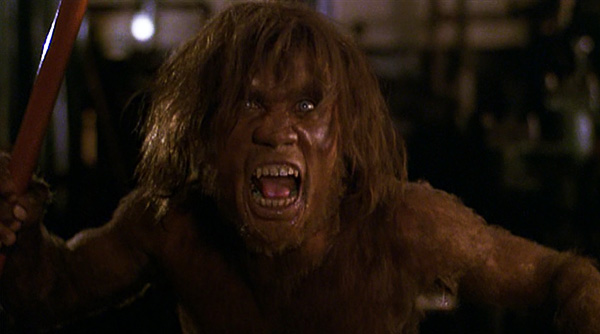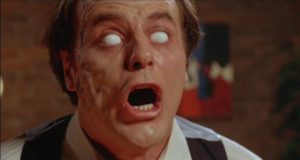
Un-Natural Selection: Evolutionary Concepts in Horror Cinema
By James Thompson

Evolution doesn’t seem scary. It is the processes of change in heritable traits of biological entities over successive generations, which give rise to biological diversity between and within organisms. This isn’t something likely to make you cower behind your popcorn box at the multiplex. However, the horror genre has frequently borrowed from science to create cinematic nightmares and evolutionary concepts provide a rich source of raw materials. In this piece I outline four key themes in horror cinema: ‘super-evolved monsters’, ‘abomination’, ‘devolution’ and ‘monstrous mutation’ all of which are informed by evolutionary science, and along the way I’ll suggest a few films for your Halloween viewing pleasure.
Like the harbinger of doom in any good slasher movie I must offer some warnings. Firstly, horror films frequently misrepresent the reality of evolutionary science; the underlying themes are influenced by evolution, but no film discussed is scientifically accurate. Secondly, this isn’t an exhaustive review; I’d welcome you to consider these themes in relation to your own horror favourites. Thirdly, some of the hyperlinks link to scenes of a graphic nature. And lastly, there may be spoilers ahead. You have been warned!
‘Perfect Organism’: Super-Evolved Monsters
The ‘super-evolved’ monster theme involves the films protagonists encountering a creature which challenges the belief that human beings are a supreme species. Alien (1979 dir Ridley Scott) is a sci-fi horror where the crew of a commercial spaceship are sent to investigate an unknown planet and encounter a colony of eggs. An egg hatches and a crew member gets attacked by a ‘face hugger’ which implants a larva in his chest (the pupation of which is one of cinemas most memorable scenes). This alien rapidly develops into a terrifying predator which picks off the ship’s crew.
The horror in Alien and within this theme is twofold. Firstly, it’s no fun to encounter a creature which eats you or uses you as part of a parasitoid reproductive cycle. Secondly, according to blogger Emma Bell, Alien reminds us of the reality that humans are not the pinnacle of evolution (the character Ash within the film describes the Alien as a ‘perfect organism’). ‘Super-evolved monsters’ illustrate that there is no ‘evolutionary ladder’ with human beings at the apex. Instead the brute nature of biological evolution means that there are just creatures more or less well adapted to a particular environment. This is unsettling because it renders the attributes humans have evolved which have lead to our apparent supremacy on earth, such as language use and technology, useless when faced with a new un-human creature whose adaptations render us prey. This makes us reflect on what humans are in biological terms and here the evolutionary horror gets existential.
Other notable films in the ‘super-evolved’ monster category include:
- Mimic (1997 dir Guillermo del Torro) Genetically engineered predatory insects rapidly ‘evolve’ into a giant species capable of ‘mimicking’ humans to catch us as prey.
- The Blob (1988) A giant amoeba eats a small US town; a seemingly ‘under-evolved’ entity challenges human species supremacy.
- The Thing (1982 dir John Carpenter) An Antarctic research team encounter an alien with some spectacular biological adaptations which make it the ultimate threat to human species supremacy (This film is brilliant so I’m avoiding spoilers. Not for the squeamish)
‘Abomination’: Crossing Species Boundaries
‘Abomination’ is the term I’m using to describe horror which results from the crossing of species boundaries; by combining the physiological traits of one species with another. Typically this cross-over is between a human and another animal with unpleasant results. In the natural world it is usually not possible for different species to combine traits; if they attempt to breed they seldom produce fertile offspring. As such, species are typically reproductively isolated and only pass on heritable traits within species. In the unnatural world of the horror film genetic traits between species are frequently mashed together through a number of different plot devices, creating hybrids.
There are two key components to horrors that cross species boundaries and I will use two different films to illustrate them. The Island of Lost Souls (1932 dir Earl C Keaton)- the best cinematic adaptation of H G Wells’ novel- tells the story of a sailor who becomes stranded on a mysterious island owned by Dr Moreau; a vivisectionist with a God complex, who uses surgery to ‘advance’ evolution creating human like beast-mean from animals. The unnaturalness of Moreau’s creations are a source of horror because they violate species boundaries, but also because they reflect anxieties about what evolution means for humans: unsettling the notion that man is separate from animals. A more visceral example of the horrors of combining species is the excellent The Fly (1986 dir David Cronenberg). Here a scientist, Seth Brundle becomes genetically fused with a housefly after an accident with a matter transporter. The combination of traits between species lead him to slowly and gruesomely turn into a man-fly hybrid; losing his humanity, along with his fingernails, teeth, and table manners. This is a visually striking depiction of the physical horror of combining species traits which shouldn’t mix.
Other notable films in the ‘abomination’ theme include:
- Splice (2009 dir Vincenzo Natali): Genetic engineers splice human DNA into a synthetic animal with the kind of results you’d expect in a horror film. Not to my taste but it has its fans.
- Human animal combination is a staple theme of horror more generally: see An American Werewolf in London (1981 dir John Landis), and the brilliantly bonkers Matango (1963 dir Ishiro Honda) where people combine with mushrooms.
Devolution: Primal Fear
Devolution represents a horror of species regression and is based on the concept that evolution can go backwards; that more complex or advanced organisms can revert to more simple or primitive ones. This misconception has been abandoned in evolutionary science as it relies on the false notion that evolution ‘advances’ leading to increasingly complex organisms in some sort of progression. Instead, evolutionary change occurs based on the factors of natural selection and genetics; the apparent complexity or simplicity of an organism is irrelevant to its change over generations and the idea of progress or ‘advancement’ does not apply.
In spite of this scientific reality the horror genre has applied the concept of devolution to humans; where they ‘revert’ to monstrous and dangerous biological ancestors. In the film Altered States (1980 dir Ken Russell) psychologist Edward Jessop’s experiments in a flotation tank with a hallucinogenic cocktail cause him to biologically devolve, firstly into a murderous primate like proto-human and then through further experiments into a blob of conscious primordial ooze. Once brought back from this state Jessop’s existence is threatened as he spontaneously devolves into a state non-material consciousness (a philosophically contentious notion!). The horror of devolution in Altered States is primarily biological as it threatens Jessop’s humanity in physical terms. A film that explores the loss of humanity through devolution in more moralistic or behavioural terms is Dr Jekyll & Mr Hyde (1931 dir Rouben Mamoulian) adapted from Stephenson’s novel. Here evolution is represented as progress from the primitive to the advanced, both biologically and culturally. In the film, when Dr Jekyll becomes Mr Hyde he ‘devolves’ into a primate like proto-human with his appearance becoming more simian with each transformation. Similarly, his behaviour becomes increasingly ‘primitive’ as with each successive devolution he becomes more in thrall to ‘base impulses’ (namely sex and violence). This excellent adaptation combines the 20th century anxieties around the ‘animal’ nature of man: expressed biologically through evolution and psychologically through Freudianism. Devolution as a theme unsettles through the assertion that humanities baser, more animal, self is always just below the surface.
Other notable films involving ‘devolution’:
- Spider Baby (1968 dir Jack Hill): a black horror comedy about a family suffering from the fictional ‘Merrye Syndrome’ which casues them to devolve into murderous cannibals. More fun than it sounds if you have a dark sense of humour.
- For a more traditionally comedic take on the idea of ‘devolution’ see Garth Marenghi’s Darkplace, Episode 4, The Apes of Wrath
Monstrous Mutation
Mutation in horror films is always monstrous. Mutation is the change in an organisms DNA which can alter physiology, appearance and/or behaviour. These alterations are random and can be harmful, beneficial, or neutral to an organism. Mutation affects a range of physiological aspects of an organism in isolation (somatic mutation) or if the mutation occurs in reproductive cells can be passed on to offspring (germline mutation; this is important in evolution). Germline mutations can result in phenotype change in successive generations of various magnitudes. In horror cinema, germline and somatic mutations almost always result in some attribute that is harmful; not necessarily to the ‘mutants’ themselves but to the hapless people who cross their path.
Both germline and somatic mutations are represented in horror movies. In The Hills Have Eyes (1997 dir Wes Craven) and its 2006 remake (dir Alexandre Aja), germline mutation leads to a phenotypic change of disturbing appearance and violent behaviour. In both films a nuclear family driving through the North American desert stray from the beaten path and encounter a hostile family of mutants. In the original film, the cannibal family’s appearance and brutality are attributed to a random germline mutation from their father (Jupiter). In the 2006 remake the mutations are attributed to germline mutations caused by their forebears’ exposure to gamma radiation resulting from their refusal to leave their home in an atomic testing site. Somatic mutation is an underlying concept in the Canadian horror film Scanners (1981 dir David Cronenberg). In this film in utero exposure to a drug called ‘Ephemerol’ triggers a somatic mutation which creates ‘scanners’; individuals’ with powerful and dangerous psychic and telekinetic abilities (brilliantly demonstrated in this infamous clip). Whilst in evolution mutation can be a positive force of adaptive change, in the horror film it is seldom a good thing.

Scanners, 1981. Dir. David Cronenberg
Other notable films about ‘monstrous mutation’:
- Death Line (1972 dir Gary Sherman): people are disappearing on the London Underground due to an inbred cannibal family descended from trapped Victorian railway workers. A grim yet quirky cult classic, especially for fans of tea.
That brings us to the end of my review of the use of evolutionary concepts in horror cinema, you can rest easy having survived the biological bestiary of super-evolved monsters, cross species abominations, the dangerously devolved and murderous mutants. But just before the credits roll on this post I’d like to offer one last evolutionary scare; after all the best horror films leave you with a lingering sense of unease. What does the genre have to say about the future of human evolution? One prediction about the future of human evolution is that humans will change through interface with technology; that man and machine will become one. For a horrific take on this, look to Japanese body horror Tetsuo: The Iron Man (1989 dir Shinya Tsukamoto), a nightmarish cyberpunk vision of a man fusing with metal and becoming a hideous bio-mechanical monster. At the films close the machine-human hybrid monster seeks to overrun the world and turn it into metal. Tsukamoto offers a terrifying and symbolic comment on human machine interface, and one which asks a dark question about future human evolution mediated by technology. Consider this before you close this blog on your laptop or smartphone….
Further reading:
Cruz, Ronald Allan Lopez. “Mutations and metamorphoses: Body horror is biological horror.” Journal of Popular Film and Television 40, no. 4 (2012): 160-168. Available online
Bell, Emma. ‘Specious Evolution: The Horror of Darwin in Alien & Prometheus’ (2014) thinkingfilm blog
Jones, D. (2002) Horror: A Thematic History in Fiction and Film. Oxford: Oxford University Press
Newman, K. & Marriot, J. (2013) Horror! The definitive companion to the most terrifying movies ever made. Dubai: Carlton Books

